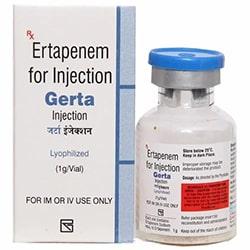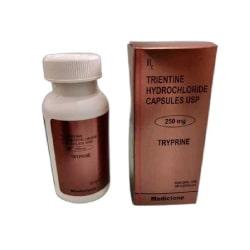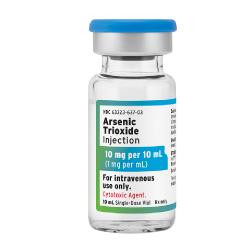Description
Ertapenem 1gm injection is a penem antibiotic used to treat moderate-to-severe infections resulting from sensitive bacteria in both adult and pediatric patients (3 months of age and up):
- Complicated intra-abdominal infections.
- Community-acquired pneumonia.
- complicated UTIs, such as pyelonephritis for example.
- Acute pelvic infections including septic abortion, postpartum endomyometritis, and post surgical gynecologic infections.
- complex infections of the skin and skin structure, such as infections of the diabetic foot that do not involve osteomyelitis.
- Adults undergoing elective colorectal surgery can utilize Gerta injection to prevent surgical site infections.
Dosage and Side Effects
Ertapenem can be given through intravenous infusion for a maximum of 14 days or via intramuscular injection for up to 7 days. When administered intravenously, it should be slowly infused over a 30-minute period. The 1 gm dose of ertapenem through intramuscular injection can be an alternative treatment for infections where this type of therapy is suitable.
For moderate to severe infections caused by susceptible bacteria:
- Adults and patients aged 13 years and above are typically given a 1-gram dose once daily either intravenously or intramuscularly.
- Patients aged 3 months to 12 years receive a dose of 15 mg/kg twice daily (not exceeding 1 g/day intravenously or intramuscularly).
For preventive measures in adults undergoing colorectal surgery, a single 1-gram dose is recommended, administered one hour before the procedure.
Important to note: Do not mix ertapenem 1gm injection with other medications or use diluents containing dextrose (glucose).
The most frequently reported side effects of Ertapenem are:
- In adults: complications at the infusion site, diarrhea, nausea, and headaches.
- In pediatric patients: diarrhea, vomiting, and pain at the injection site.
FAQ's
What conditions does Ertapenem treat?
Ertapenem is effective in treating severe bacterial infections in various parts of the body, including the skin, stomach, lungs, pelvis, and urinary tract. It’s also used to prevent infections in individuals undergoing specific types of surgery.
How is Ertapenem administered?
Ertapenem is available as a sterile lyophilized powder in single-dose vials. It can be administered either through intravenous infusion or by intramuscular injection. Your healthcare provider will determine the appropriate method based on your condition.






